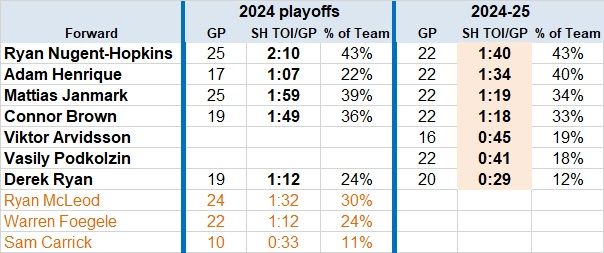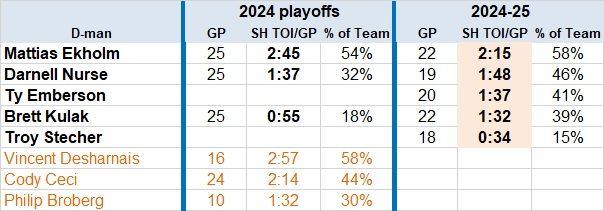A lot of things went right for the Edmonton Oilers in the 2024 playoffs. So right, in fact, that it’s still a bit hard to accept that the Oil didn’t skate away with the Stanley Cup.
Recommended Videos
Consider:
- Connor McDavid set an all-time record for assists (34) in one playoff season, and scored the most playoff points (42) of any NHLer this century.
- Evan Bouchard set an all-time record for assists (26) in one playoff season, and scored the most playoff points (32) of any NHL defenceman this century.
- Zach Hyman scored the most goals (16) in one playoff season of any NHLer this century.
- The Oilers as a team posted the best penalty-killing percentage (94.3%) of any conference finalist in the history of the four-series era (1979-present).
The individual performances hearkened back to the glory days, back when famous Oilers named Wayne Gretzky, Paul Coffey and Jari Kurri established (or in one case, tied) those exact same NHL records for players in the previous century.
PK dominance
It’s that last bullet point that was entirely new and different to Oil fans. The squad’s clearance rate of 94.3% on the kill was unprecedented among teams to advance deep into the playoffs. Indeed, it got better as the playoffs went along, with the Oilers outscoring Dallas 1-0 during the 28 minutes the Stars had the man advantage in the Western Conference Finals, then outscoring Florida 2-1 during the 38:15 the Panthers had the extra man in the Stanley Cup Finals. Not only did the Oilers kill off one penalty after another, every once in a while Mattias Janmark and/or Connor Brown would deliver a massive shorthanded goal at an important time.
Here’s the tale of the tape:
Even against the Canucks their 86.2% clearance rate was excellent. Against the others? Off-the-charts great.
I took an hour or so today to watch 6 games worth of video of that playoff PK in action: how they killed overlapping penalties in Game 6 vs. Vancouver including a minute of 3v5; how they killed a 4-minute high-sticking penalty in Game 7 of that same series without allowing a shot on goal; how Brown and Janmark broke away 2-on-1 to score the game-winner in Game 4 vs. Dallas; how those same two players opened the scoring in both Games 4 and 5 vs. Florida with quick strikes on the counter attack.
It was more than just those two guys, of course, a successful PK involves everyone on the unit from the goaltender on out. Some of those players remain, including netminder Stu Skinner, core left-shot defenders Mattias Ekholm and Darnell Nurse with Brett Kulak on spot duty, forwards Ryan Nugent-Hopkins, Derek Ryan, Adam Henrique along with Brown and Janmark. All remain with the Oilers today. But sprinkled among them were a handful of players who have moved on: forwards Ryan McLeod and Warren Foegele along with right-shot rearguards Cody Ceci and Vince Desharnais, the latter who led all Oilers in shorthanded ice time per game.
Personnel changes
It’s a different group today, and one that has had all kinds of trouble this early season. Some of it involves some of the same players not being quite as sharp in the fall as they were in the spring. But it’s also been an issue to find the right combinations.
Nugent-Hopkins was asked about the PK during a recent media scrum and provided this thoughtful response:
- “We’re definitely a moving kill, so you gotta to be on the same page. Your routes have to be really good, and obviously you need the saves when they break you down, because it is going to happen at times. Lately all those aspects have been better. Getting to where we want to be, getting to where we ended last year, obviously we still have work to do and we want to keep improving but more reps we get with each other the better we’re going to get…
[on personnel changes] It makes a difference. Up front you want to get to know each other, get your pairs going. Same on the back end, those guys had their pairs last year, it’s changed this year, I’m sure there’s an adjustment period for them just like there is with us. The more you play together and the more you take reps, the easier it is and the more you can just read off each other.”
For sure there have been changes up front, even as the four main minute munchers are all returnees.
Forward deployment
Don’t be fooled by raw TOI numbers showing almost everyone’s minutes dropping. Point being the whole team has dropped from an average of 5:05 per game on the kill in the playoffs, to just 3:54 in the new season. Two things at play here: the club is taking fewer penalties (just 2.5 per game so far compared to 2.8) and the average kills are of shorter duration, given how many more powerplays have been ended “early” with a goal against rather than a return to grace after the full two minutes in the sin bin. (More on those goals results shortly.)
Perhaps the more useful number above is the derived “% of Team” column. RNH for example led the forwards by playing 43% of the team’s shorthanded minutes in the playoffs, and lo and behold he’s at exactly the same rate this young season even as he’s down by a half-minute per game. He is, however, adjusting to a new “line-mate” in Henrique, having spent the lion’s share of his time with Ryan during the playoffs. Note how Henrique’s responsibilities have nearly doubled from 22% to 40% while Ryan’s have been halved. Looks like a changing of the guard there.
Janmark and Brown remain a fine duo, selectively aggressive in the neutral zone and not shy about carrying the puck when they get it rather than just dumping it down. Further down the pecking order are newcomers Viktor Arvidsson and Vasily Podkolzin. Departed players are shown at bottom for comparison purposes.
D-ployment
There’s been a much bigger shake-up on the back end. The top three lefties remain in the mix, but there’s been a major shake-up on the right side, other than Evan Bouchard who remains a bit player on this unit. Gone is Vincent Desharnais who led the entire team in shorthanded ice time per game, even as he eventually came out of the line-up. Cody Ceci had a big role as well, and Philip Broberg got his reps.
Both Mattias Ekholm and Darnell Nurse have seen an uptick in their (percentage of) minutes, indeed they were the starting PK pair earlier in the season. They have since been split up with both playing left side on consecutive pairings. Brett Kulak has seen a significant increase in his role on the PK just as he has at even strength, from “fifth man” minutes stepping in when another D is in the box, to taking a regular turn on the right side. Ty Emberson fills out the main quartet, indeed early evidence suggests he has helped settle down the group as a whole.
Let’s have a look:
Same format as up top. No playoff series to subdivide results, so we’ll divide the early season into three similarly-sized clusters of roughly series length. The results were beyond atrocious in the first 7 games, 10 goals against in barely half an hour. Things got a little better with clean sheets in Games 8 and 9, followed by 6 straight games with exactly 1 PPGA. It was like starting a goal down every night, exacerbated by Edmonton’s own powerplay unit being in its own funk.
By the 15 game mark, the Oil had allowed 16 PPG, more than 1 per game. That’s when two things happened:
Skinner scolding
When Vancouver scored a seemingly meaningless powerplay goal in the final minute of a 7-3 Edmonton win in Game 15, Skinner had apparently seen enough. In a post presciently headlined Stu Skinner’s frustration evident after Oilers’ latest PK fail, I wrote:
- down the stretch, Evan Bouchard took a careless penalty, then Darnell Nurse swatted down a puck right onto the stick of Elias Pettersson in the slot, in a flash the puck was in the net, and Stu Skinner was not happy. The game ended seconds later and the usually-affable stopper remained agitated.
Speculating on what might have set him off:
- My other thought is that Skinner is even more frustrated than Oilers fans with the ongoing misadventures of the penalty kill unit of which he is a feature member. The late tally marked 6 straight games the PK unit has allowed a goal, and the 12th time in 15 games overall. It’s a sorry record that sees Edmonton rank dead last in the league in penalty kill success rate (59%, or 6% worse than any other team) and in PPGA per 60 (16.5, or 2.3 worse than anybody else). The Oil are one of just 5 teams in the league to be shorthanded for less than an hour, but are nonetheless second worst in total goals allowed (16 in 58 minutes; leader Boston has allowed 17 in 106 minutes).
Some weeks later that Pius Suter tally remains the last powerplay goal the Oilers have allowed. After 6 straight games allowing 1 PPGA, they’ve responded with 7 straight allowing none at all. Coincidence? Or not?
With the run the club has improved to 30th in the league at a still-poor 70.9%, but at least they are no longer being lapped by the entire field.
Emberson effect
The other, more tangible item involves a change in deployment on the back end. The very next game, the coaching staff inserted Emberson on the first unit alongside Ekholm who returned to his natural side after encountering problems on the other. That night the new tandem played 2:25 of the 4:00 the Oilers were short, and have continued to take on fully half of the PK minutes (13:21 of 26:31). Each has played a tiny bit more when apart, with Emberson leading the way at 15:43 overall = 2:15 per game or 59% of team.
That’s a massive step up from the 32% share he had been entrusted with in the first 15 games.In a sense, he took a similar step as Desharnais did before him; third unit at evens, first on the penalty kill. He’s not as imposing a player, then again he’s not as expensive either. Oilers sure needed someone to step up.
While 7 games is hardly enough to declare Emberson the saviour, the stats are pretty stark… the unit had been the worst in the league, and hasn’t given up a single goal since the change. Let’s just say “promising” and keep an eye on what happens next.
Let’s bear in mind that we are dealing with barely a quarter of the season, in a highly-leveraged game state that represents <10% of all game time. It doesn’t take a lot for hot or cold streaks to develop.
“Distribution” is a fickle beast. Take for example Skinner, whose .800 save percentage vs. the powerplay currently ranks 33rd among the 38 goalies with 10+ GP. Bear in mind this is the same man who was #1 with a bullet in this same category in the playoffs, with a gaudy .947.
Then there’s the startling case of Darnell Nurse, who has been on the ice for 13 of the 16 PPGA despite playing something under half of the minutes. The same guy played over 40 minutes on the kill last playoffs and was victimized for exactly ZERO goals against that entire time. Unless you care to make the case that Nurse had a better PK partner last year in Cody Ceci than he had early this season in Ekholm, it’s hard to explain without a lot of hand-waving and repeated sample size warnings.
The long and short of it? The Oilers’ PK was terrible early, has experienced a sharp correction in recent games, and remains a work in progress. Ty Emberson may be part of the solution.
Recently at the Cult of Hockey
STAPLES: Oilers ace ripped for “bad body language”
McCURDY: Oilers turn to Plans B, C and D on their depleted wings
STAPLES: Oilers’ primary need remains on the blueline, pundits agree
STAPLES: Don Cherry takes a run at Darnell Nurse over response to Reaves hit


and on Bluesky Social @brucemccurdy.bsky.social
Follow me on X-Twitter @BruceMcCurdy
and on Bluesky Social @brucemccurdy.bsky.social



